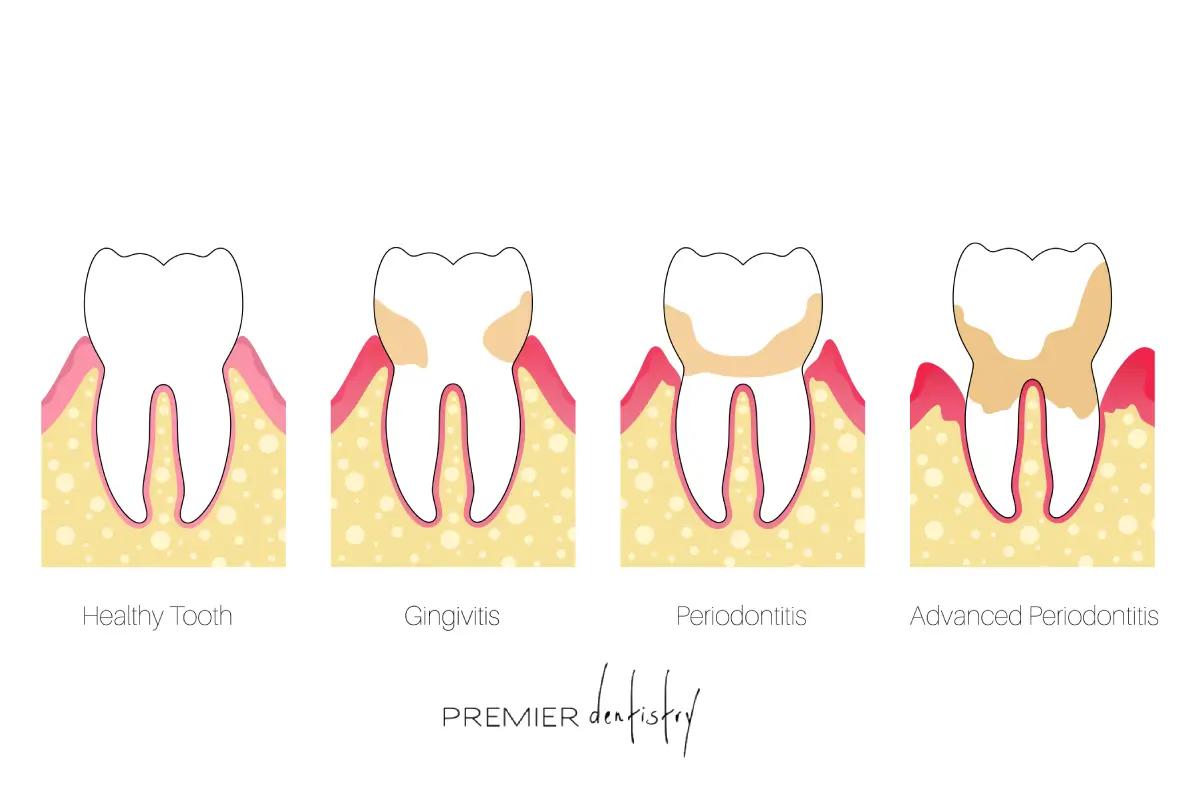


Think your gums are fine because it doesn’t hurt? Think again. Gum disease silently destroys bone and teeth—often without warning.
Catch it early, and you can save your smile, your money, and your confidence.
Picture this: You look in the mirror one day and notice your teeth look longer… your smile feels different… and suddenly a tooth is loose. That “sudden” moment? It actually started years ago — while you felt nothing at all. Almost HALF of adults over 30 already have gum disease destroying the bone around their teeth right now (CDC) — and 99% of them have no pain until it’s expensive or too late.
But here’s what most dentists won’t tell you upfront:
If we catch it in stage 1 or 2, we can almost always stop it completely — and you keep every single tooth.
The 4 stages (and how fast they sneak up):
Every single day you wait, you lose bone that will never comes back on its own. But every patient who walks through our door today saying “I should have come sooner” leaves saying “I’m so glad I finally did.” Don’t let your smile become another regret story.
Book your quick, painless gum check right now — most people discover they’re only in stage 1 or 2 and breathe a huge sigh of relief.
Book an appointment or call us. Your future smile is counting on you today.

Gingivitis is the first stage of gum disease. It happens when plaque (a sticky film of bacteria) builds up on teeth and makes the gums sore.
Common signs:
Good news: There is no damage to the bone or tissues yet.
Pocket depths are still normal (1–3 mm).
With a professional cleaning and better daily brushing and flossing, gingivitis goes away completely in just 1–2 weeks.
Most patients who bleed during their cleaning are at this stage — and they leave with perfectly healthy gums.
Now the infection has moved below the gum line. Small pockets (4–5 mm) form between the teeth and gums.
Signs you may notice:
The bone has lost 10–20% of its support (we can see this on X-rays).
Treatment: A deeper cleaning called scaling and root planing (done comfortably with numbing). We often place tiny antibiotic beads right where they’re needed.
When patients follow up every 3 months, the disease stops in over 95% of cases. We can still save every tooth at this stage.
Pockets are now deeper (6–7 mm). Gums pull back, teeth may feel a little loose, and spaces can appear between teeth. Bone loss is 30–50%.
Treatment: We often use laser therapy or gentle surgery to clean deeply and help the gums reattach. With regular care, we can stop the disease and sometimes even grow new bone.
Pockets are very deep (over 7 mm). There is major bone loss (over 50%), and teeth can shift, shift or become very loose.
Signs:
Treatment: More advanced surgery, bone grafts, splinting loose teeth, and sometimes removing teeth that cannot be saved and replacing them with implants.
At this stage our goal is to save as many natural teeth as possible and restore a healthy, comfortable smile.
The earlier gum disease is found and treated, the easier it is to fix — and the more teeth we can save for life.
| Stage | Pocket Depth | Bone Loss | Reversibility | Typical Treatment |
|---|---|---|---|---|
| 1. Gingivitis | 1–3 mm | None | 100% reversible | Pro cleaning + better hygiene |
| 2. Early Periodontitis | 4–5 mm | 10–20% | Stops with treatment | Deep cleaning (scaling/root planing) |
| 3. Moderate | 6–7 mm | 30–50% | Halts with surgery | Laser therapy or flap surgery |
| 4. Advanced | ≥8 mm | >50% | Partial salvage only | Surgery, grafting, implants |
The four stages are:
Yes — 100% reversible with a professional cleaning and better daily brushing and flossing.
It can take anywhere from a few months to 10+ years. Smoking, diabetes, and poor hygiene make it progress 2–3 times faster.
Yes. We save teeth every week that other offices said needed to be pulled.
Only a dentist can tell for sure. We gently measure the pockets around your teeth and take X-rays to see any bone loss. Most people have no idea they have it until we check.
Pregnancy gingivitis is very common because of hormones. It is safely treated with gentle professional cleanings (safe in all trimesters), better home care, and special rinses. We avoid unnecessary medicines and X-rays.
The 3-3-3 rule is a short-term way to control toothache pain: take 3 ibuprofen tablets (200 mg each = 600 mg total) three times a day for up to three days — but only if ibuprofen is safe for you. It helps reduce swelling while you wait for your dental visit. Always call us instead of relying on pills.
The bacteria from infected gums can travel through the bloodstream and raise the risk of:
Good oral health protects your whole body.
Rarely on its own, but if the infection becomes severe and spreads (sepsis), it can cause stomach upset, vomiting, or diarrhea along with fever and feeling very sick. This is an emergency — come in right away or go to the ER.
Ready to find out your exact stage and stop gum disease before it causes bigger problems?
Call us today or book online for a gentle, no-pressure periodontal check. Most insurance accepted, payment plans available.
Check our patient resources page. Ready to Smile Brighter? Book Your Consultation Today
Schedule Your Free Consultation or call (503) 667-1184. Let’s get you on the path to straighter teeth—your Gresham smile awaits!
Ready to find your dentist near me in Gresham? At Premier Dentistry, we’re excited to welcome you to our dental clinic.
Don’t wait—join the Premier Dentistry family today and experience why we’re the top Gresham dentist for new patients.